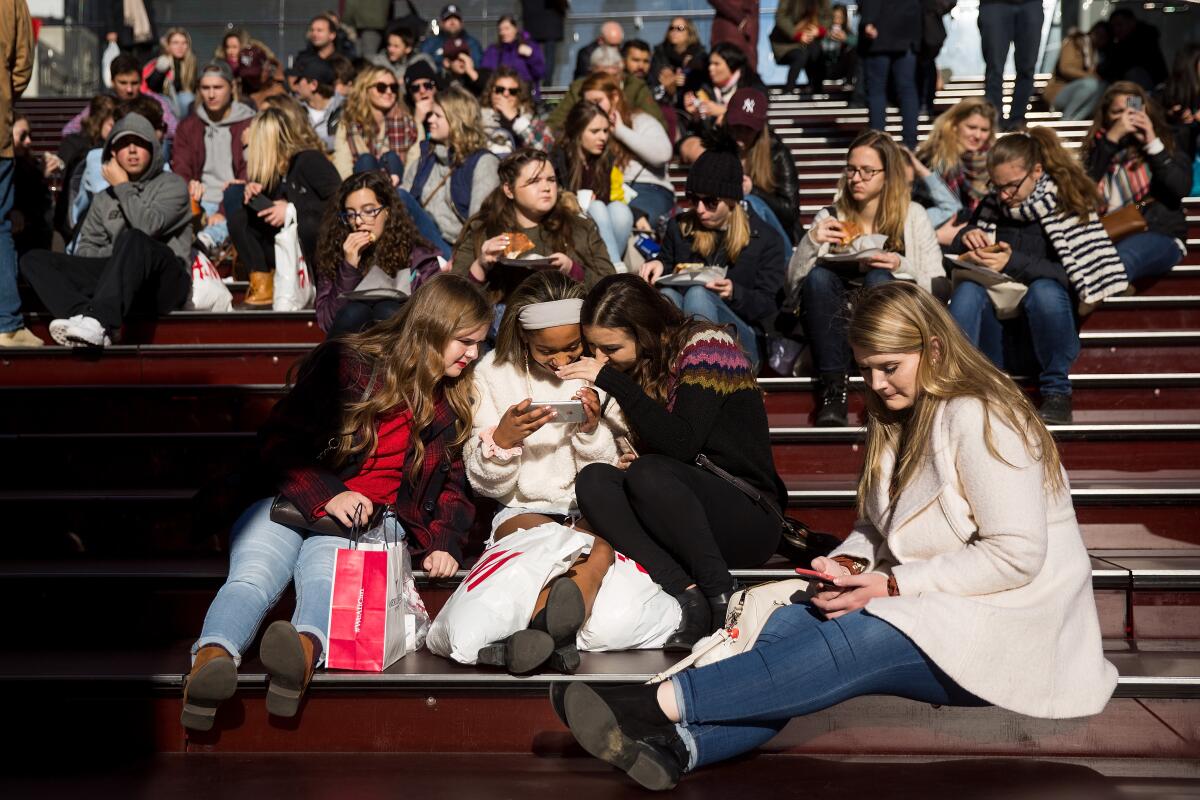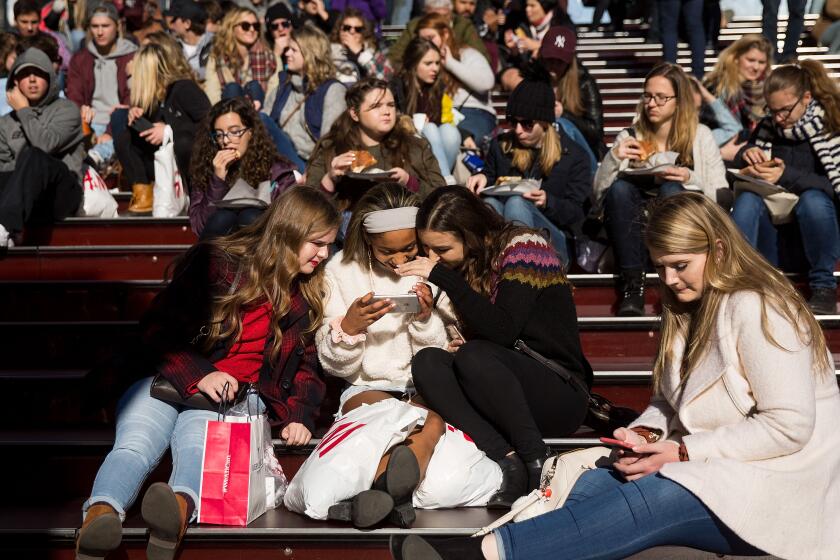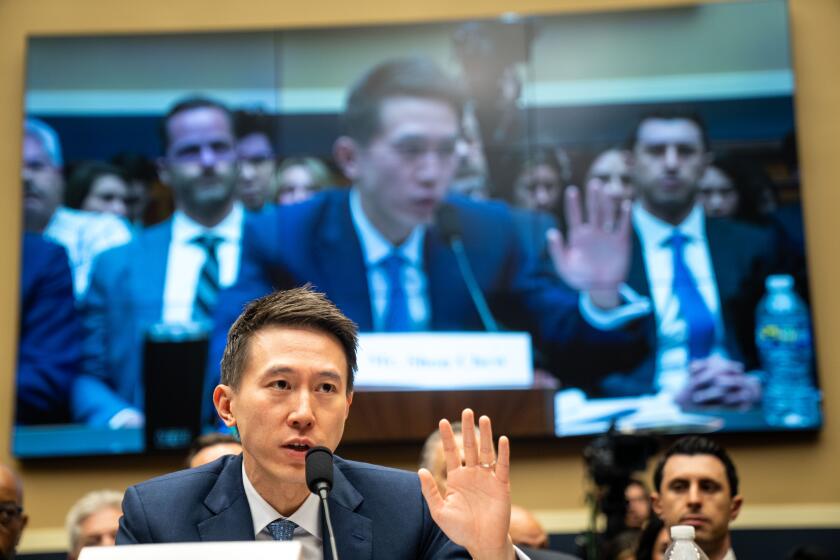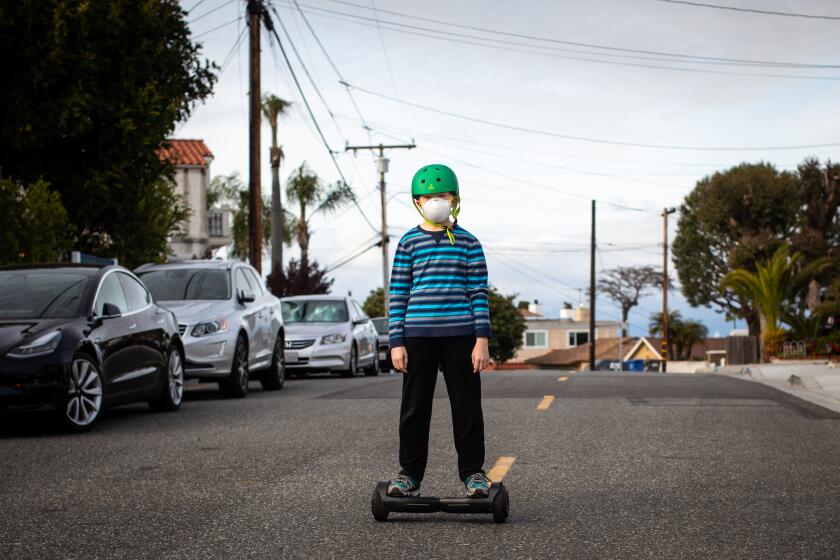Commentary: Protect kids from the harms of social media? Parents can’t do it alone

- Share via
Last week the United States surgeon general, Dr. Vivek Murthy, joined a growing chorus of health professionals warning that social media use has an unchecked and potentially destructive effect on young people’s mental health.
In his advisory, Murthy said there is enough evidence that social media platforms are harming children and teens’ well-being that parents, policymakers and tech companies should act now to reduce the risks. The American Psychological Assn. issued similar recommendations earlier this month, including urging parents to closely monitor their kids’ use of social media.
The guidance is sound and much needed, but for parents it’s easier said than done. As a mother of two sons, 14 and 12, I constantly struggle to keep a lid on their social media and enforce limits on phone usage in general. The sooner Congress or federal regulators develop safety standards for social media platforms, the better.
California lawmakers should advance legislation to make social media safer for children and keep pressure on Congress to craft a national fix.
Just think about what young people are saying in surveys Murthy cites: Up to 95% of kids aged 13-17 are using at least one platform and a third say they use social media “almost constantly.” Nearly half (46%) of teens said social media use makes them feel worse about their body image. And nearly 6 in 10 adolescent girls say they’ve been contacted by a stranger on social media platforms in ways that make them feel uncomfortable.
And it’s not just harmful or inappropriate content that’s the problem, Murthy points out. It’s also the staggering amount of time young people spend online. In a survey of eighth- and 10th-graders, the average time spent on social media is 3.5 hours per day, with roughly 25% spending five or more hours per day.
Kids recognize the power that social media apps have over them. Nearly 75% of teenagers surveyed believe that technology companies manipulate users to spend more time on their devices.
It makes sense to delay giving younger kids smartphones, but older tweens and teens are generally expected to have phones and be on social media. Schools use apps for assignments and grades. Sports teams post game highlights on social media. It’s how kids make plans, communicate and express themselves, and the independence that comes with having a phone and the ability to connect on social media can be healthy and empowering.
Concerns about users’ privacy, disinformation and impacts on children are not unique to TikTok.
In theory, parents have tools to limit their kids’ exposure to harmful content and excessive use. But it’s like whack-a-mole trying to keep up with settings on phones and all the different apps — Instagram, TikTok, YouTube, Snapchat, Discord, Gas, Twitter — while new platforms keep popping up online. Determined kids can find workarounds that override restrictions.
Before our oldest son got a phone for his 12th birthday, we set rules. The phone would stay in the kitchen at night, not the bedroom. His parents would have the passcode and could check the phone at any time. We prohibited social media apps such as Instagram, TikTok or Facebook. (No problem there, my son said: “Only old people use Facebook,” which, of course, includes me.)
But on the same day he got the phone, he set up a Snapchat account and tried to hide it from us. He was caught because at that point, I was more technologically sophisticated than he was. That didn’t last long.
Over the last two years I’ve been able to limit but not prohibit social media use, and we still argue over the amount of time he spends staring at his phone. I’ve come to think it’s unrealistic to expect parents to oversee a device that spends more time per day with their kids than they do. The phone is there on the bus, at school, sports practices and on social outings. We talk about inappropriate content and troubling online behaviors, but at the end of the day, I don’t know what my kids are seeing online.
Vehicle sizes have ballooned in recent decades, and now children would be unsafe on bikes. History shows us a better approach.
Which is why I appreciate hearing from Murthy and other health experts that parents should not have to do this alone. “We believe the companies bear a lot of the responsibility in addressing these issues,” said Arthur C. Evans Jr., CEO of the American Psychological Assn. “We know there are features they put into the technology that make it difficult for kids to detach themselves and make it difficult for kids to do the things they need to do for normal development.”
The U.S. has a long history of setting safety standards for products such as toys, vehicles and medications to protect consumers from harm, Murthy argues in his advisory. Why not technology? Companies should also be required to make their platforms safer for young people. They should also have to share more information with independent researchers so policymakers can better understand how young people are affected by social media use and how to make it safer.
Since most companies are unwilling to take significant steps voluntarily — because they face a disadvantage if their competitors don’t — Congress must do it for them. States have already begun to pass laws to regulate social media, including California’s first-in-the-nation law requiring age-appropriate design and child privacy protection. Arkansas and Utah require parental consent for kids under 18 to use social media.
It would be far better for Congress to enact nationwide safety protections, rather than having a patchwork of localized laws. There are at least two bipartisan bills under consideration. One would make 13 the minimum age to use social media, require parental consent for older teens and prohibit companies from recommending content using algorithms to users under the age of 18. The other bill would require that social media companies reduce the potential for harm to kids and set the protective standards on kids’ accounts by default.
Of course, passing a thoughtful, comprehensive social media safety law is also easier said than done. This is complex legal and regulatory terrain that bumps up against free speech, kids’ privacy needs and federal laws protecting companies from being held liable for content posted by users on their platforms.
Nevertheless, doing nothing is not an option amid mounting evidence that social media use is harming kids’ mental health. The technology isn’t going away, so we should at least make sure young people are operating in an online world with guardrails.
More to Read
A cure for the common opinion
Get thought-provoking perspectives with our weekly newsletter.
You may occasionally receive promotional content from the Los Angeles Times.














